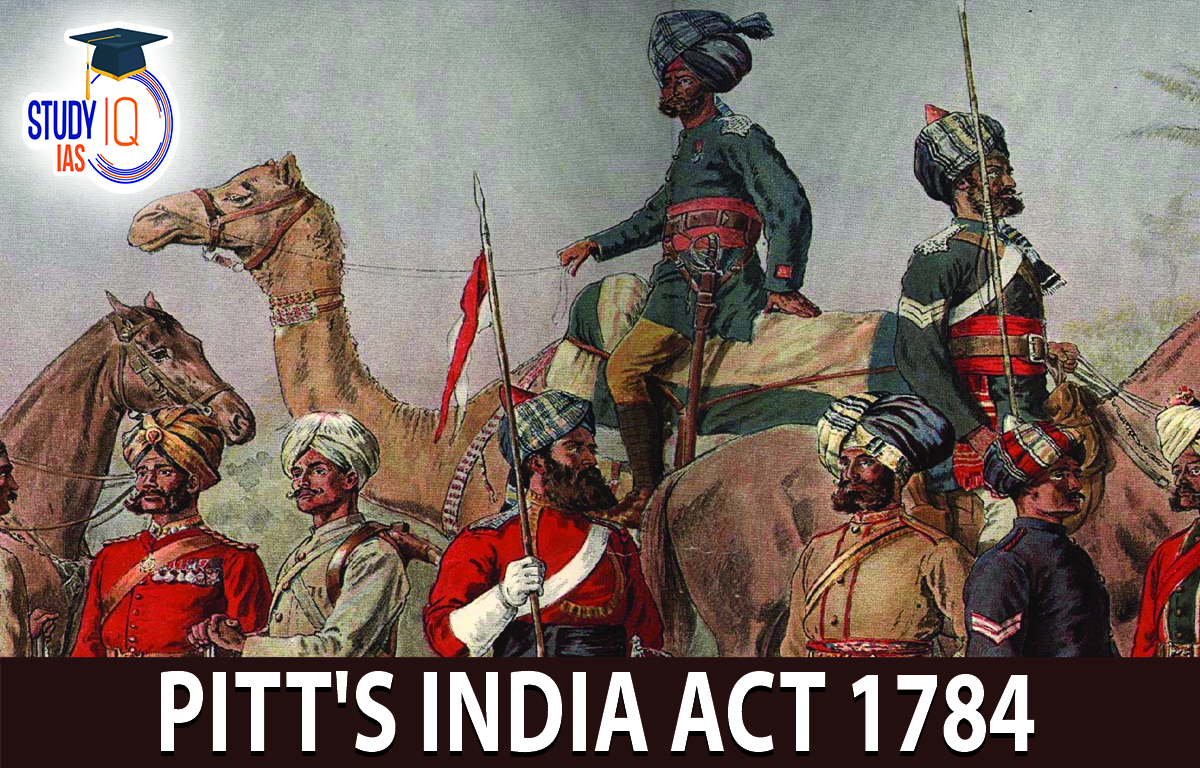Table of Contents
Pitt’s India Act 1784
August 1784 saw the passage of Pitt’s India Act. Absconds in the Regulating Act were intended to be eliminated. It was fundamentally very similar in arrangement. Public projects undertaken by the organization and its operations in India were to fall directly under the direct jurisdiction of the British Government. Since the Company’s title to regional property was already unassailable, it essentially indicated a division of the difference.
A six-member Board of Control, including two Cabinet clerics, was established by the Act. The Court of Directors and the Government of India created the Board of Control, which was to direct and oversee it. They were expected to oversee all civil and military governor matters in the British territories in India. For political and military affairs, the Court of Directors was replaced by a secret advisory panel made up of three Directors.
The East India Company’s administration in India underwent a constitutional reform. The Act outlined the rule that the public power of India is put under the Governor General and a Council of three so that, by some lucky coincidence, he may have his direction if one member of the Council upheld him. The choice was made available to the Governor General. The Act clearly stated that the Presidency of Bengal was to be superior to the Presidency of Madras and Bombay in all matters of war, strategic ties, and income.
Pitt’s India Act Features
The most important aspect of this legislation was that it established the British parliament’s authority over the East India Company. The same was accomplished by separating the company’s political and trade functions; the trading rights were given to the Court of Directors, while the Board of Control was created to regulate the company’s political activities.
As the division of powers was originally adopted, it also served as the basis for double governance, or dual government, in India. The Board of Control was given full control over both civil and revenue-related activities as well as military actions in British India.
The Council chosen by the parliament may nevertheless veto the decisions of the Indian Governor-General. However, with only three instead of four council members, the Governor-General could easily dominate his choices with the support of just one council member. The Governor-General also appreciated having the ability to veto decisions. For the first time in any statute, the areas controlled by the East India Company were referred to as the British possessions.
Pitt’s India Act 1784 Objectives
Pitt’s India Act 1784, passed in an effort to fix the problems with the 1773 Regulating Act, gave the British government control over the East India Company in India. The Pitts India Act of 1784 established a clear line between the political and commercial interests of the East India Company. Only the Company’s public programs and organizations in India were closely regulated by the government. The Board of Control was established to provide assistance in an instance very much like this.
According to the Pitts Act of 1784, experts donated to the board of directors. Once upon a time, the organization’s documents were completely accessible to the governing body. It had the power to rotate between sending governors to India. The organization must be addressed by the Court of Directors, and the Crown must be addressed by the Board of Control.
All thoughtful and army officers of the East India Company have been asked to provide the Court of Directors with a complete inventory of their property in India and in Britain within two months of starting their new positions. When the organizations preferred in India were relaxed in 1858, the charter established by Pitt’s India Act remained largely unchanged.
Pitt’s India Act 1784 Significance
The Madras and Bombay councils were amended after the Bengal Council. The number of members of the Executive Council was reduced to 3, and the Governor-General served as its commander in chief. In order to oversee the Court of Directors’ policies, a second division known as the Board of Control was being established in England. Introduction of dual government, where the firm and the Parliament are both involved. This form of government was in place until 1858.
Pitt’s India Act Limitations
The Governor-General gained an advantage as a result of the reduction in executive council members. This is the case because the Governor-General simply only one votes from the executive council to carry out his irrational judgments. In the event of a tie vote on a particular decision, the executive council and governor general’s respective powers will conflict.
While serving as the top commander of the East India Company and the Parliament was located in England, the Governor-General was stripped of his military authority. Sudden military choices must be made in emergency situations, but the Governor-General was stripped of all military authority by Pitt’s India Act in 1874. The Board of Control, the Court of Directors, and the Governor-functions General’s were not explicitly outlined.
Pitt’s India Act of 1784 UPSC
- Pitt’s India Act of 1784 established the Board of Control to oversee political issues while retaining the Court of Directors to oversee business affairs. As a result, it created a system of dual government.
- Pitt’s India Act of 1784 made a distinction between the British East India Company’s commercial and political roles.


 Maharashtra’s Mendrachi Vancharai Syst...
Maharashtra’s Mendrachi Vancharai Syst...
 Keeladi Excavation: Uncovering the Ancie...
Keeladi Excavation: Uncovering the Ancie...
 Sanyasi Revolt, Objectives, History, Rea...
Sanyasi Revolt, Objectives, History, Rea...





















